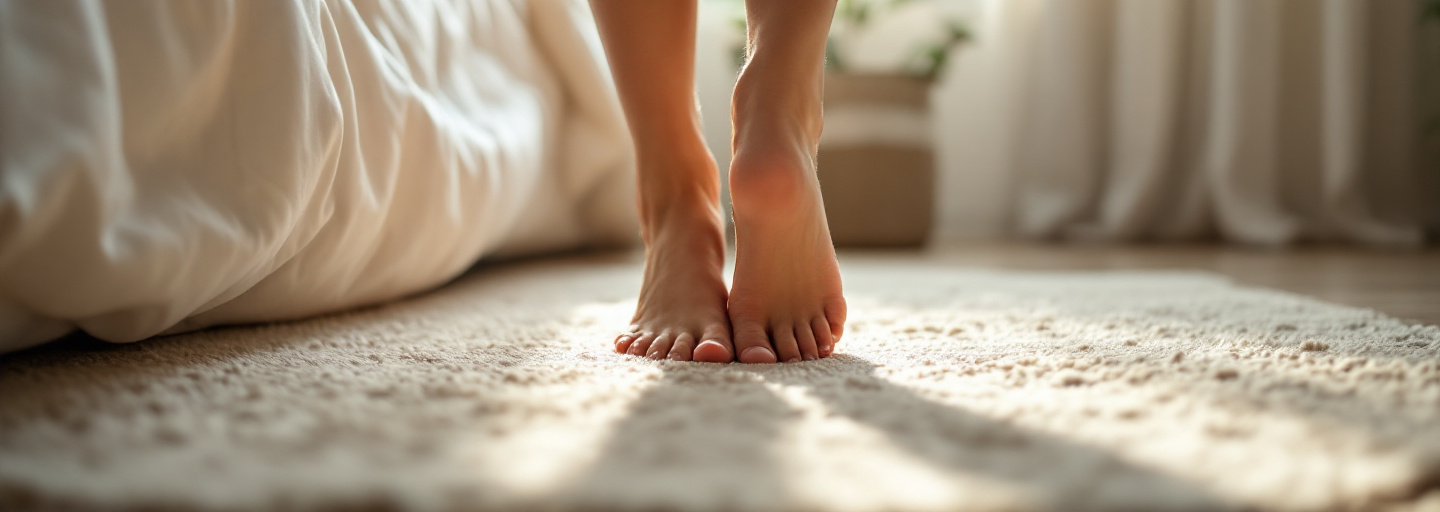Wake Up Refreshed How to Set Alarms for Less Morning Stress
« Back to all blog postsLearn how to set your alarms effectively to reduce morning stress, wake up refreshed, and start your day calmly. Practical tips for a better morning routine.

For millions, the first sound of the day isn’t birdsong or a gentle stirring, but the insistent call of an alarm clock.
While essential for modern schedules, the way we’re jolted awake can significantly impact how we feel throughout the morning, and even the entire day.
The Link Between Alarms and Morning Stress
That familiar jolt from an alarm isn’t just unpleasant; it triggers a genuine physiological response. Think of it like being startled awake by a sudden loud noise versus being gently roused. The abruptness can trigger a release of cortisol, the body’s stress hormone, even before your feet hit the floor. This contributes to what’s known as sleep inertia , that groggy, disoriented feeling that makes clear thinking difficult right after waking.
This initial stress doesn’t just vanish once you’re upright. It can set a negative tone for your entire morning, making you feel rushed, irritable, and behind schedule from the very start. Contrast that with waking up calmly, feeling like you have a moment to breathe before the day’s demands begin. The difference is palpable.
The key insight here is that the method of waking is just as crucial as the time you choose to wake up. Your alarm shouldn’t just be a tool to end sleep; it should be the first step in crafting a positive daily experience. It’s entirely possible to set alarms stress free when you approach it with intention. This involves understanding how to use alarms strategically to manage the transition from sleep to wakefulness smoothly, rather than abruptly.
Common Alarm Mistakes to Avoid
Understanding why alarms can be stressful is the first step. The next is recognizing common habits that unintentionally make mornings harder. Many of us fall into patterns that sabotage our goal of a calm start. Avoiding these pitfalls is foundational to waking up better:
- The Snooze Button Habit: It feels like you’re getting extra rest, but hitting snooze repeatedly does the opposite. It leads to sleep fragmentation , breaking the final, potentially restorative phase of sleep into low-quality, unrefreshing snippets. This actually prolongs sleep inertia, making you feel groggier for longer. If you find yourself relying on it, it’s time to stop hitting snooze button and address the root cause, whether it’s bedtime, wake time, or the alarm itself.
- Cutting It Too Close: Setting your alarm for the absolute last minute creates immediate pressure. The moment it rings, you’re racing against time. This lack of buffer guarantees a rushed feeling, fuels morning anxiety, and leaves no room for a calm, mindful transition into the day.
- Jarring and Loud Sounds: Harsh beeps, loud buzzers, or blaring music first thing in the morning activate the body’s sympathetic nervous system, our ‘fight-or-flight’ response. It’s an inherently stressful way to be pulled from sleep, creating an unpleasant jolt that lingers.
- Inconsistent Wake-Up Times: Sleeping in significantly on weekends might feel good temporarily, but it confuses your body’s internal clock, or circadian rhythm . This inconsistency makes it harder to wake up naturally during the week and can lead to a feeling similar to jetlag, sometimes called ‘social jetlag’.
Recognizing these common mistakes allows you to consciously choose different approaches, paving the way for a less stressful morning experience.
Finding Your Ideal Wake-Up Time
Moving beyond avoiding mistakes, let’s focus on proactive strategies, starting with the crucial element of timing. Aligning your alarm with your body’s natural sleep patterns can make a significant difference in how you feel upon waking.
Sleep isn’t monolithic; it occurs in cycles, typically lasting around 90 minutes each. Within these cycles, we move through different stages: light sleep, deep sleep, and REM (Rapid Eye Movement) sleep. The key takeaway is that waking during a lighter stage of sleep generally feels much less jarring and disorienting than being pulled from deep sleep.
How do you aim for this? Start by estimating your total sleep needs. While 7-9 hours is the standard recommendation for adults, individual needs vary. Once you have a target amount of sleep, work backward from your desired wake-up time in 90-minute increments. For example, if you need to wake at 7:00 AM and aim for 7.5 hours (five 90-minute cycles), counting back suggests a bedtime around 11:30 PM. This calculation helps you target waking near the end of a sleep cycle.
However, these calculations are just estimates. Treat it like personal data collection: experiment by adjusting your wake-up time slightly, perhaps by 15 minutes earlier or later for a week, and pay close attention to how you feel. Are you less groggy? More alert? This trial-and-error helps fine-tune your schedule to your unique biology.
Crucially, consistency reinforces your natural rhythm . Sticking to a regular wake-up time, even on weekends (within reason, perhaps allowing an extra hour), helps stabilize your circadian rhythm. Over time, this makes waking up feel more natural and less reliant on the alarm’s jolt. Building consistent routines is a cornerstone of effective time management; exploring more time management strategies on our blog can offer further support in establishing these healthy habits.
Optimizing Your Alarm Settings for Gentleness
Once you’ve considered *when* to wake up, the next step is optimizing the alarm itself. The specific sound, volume, and features you use can transform the alarm from a source of stress into a gentler nudge awake. Here are some gentle alarm clock tips :
Sound Selection Matters: Ditch the harsh, repetitive beeps. Opt for sounds that are gradual, melodic, or mimic nature. Think sounds that start softly and build slowly (a crescendo effect), pleasant chimes, or calming natural sounds like birdsong or flowing water. These are less likely to trigger that jarring startle response compared to abrupt, high-frequency noises.
Volume Control Strategy: Loud doesn’t necessarily mean effective. Start the alarm volume low, just enough to gently stir you. If your alarm allows, choose an option where the volume gradually increases. The goal is a gentle prompt, not an auditory shockwave.
Exploring Vibration: Don’t overlook the power of vibration. For light sleepers, those sharing a bed, or individuals with hearing difficulties, a vibrating alarm can be a highly effective and much less intrusive alternative or supplement to sound.
Utilizing Tool Features: Modern tools make implementing these strategies easier. For instance, using online platforms allows you to set precise times and leverage your device’s sound library for customization. Features like our preset alarms feature let you easily save and manage different alarm configurations, helping you find the best way to set alarm settings tailored to your personal preferences and needs.
| Sound Type | Characteristics | Potential Impact on Waking |
|---|---|---|
| Abrupt Beeps/Buzzers | Sudden onset, often harsh, repetitive, high frequency | Can trigger startle response, increase stress, contribute significantly to sleep inertia |
| Loud/High-Energy Music | Can be jarring if starts loud, may have inconsistent volume | Effectiveness varies; can be stressful if too intense immediately upon waking |
| Gradual Melodies/Chimes | Starts softly, increases volume slowly, often uses pleasant tones | Allows for a gentler transition from sleep, less likely to cause shock or stress |
| Natural Sounds (Birds, Water) | Mimics environmental sounds, often calming and consistent | Can create a more peaceful waking experience, potentially reducing grogginess |
Note: Individual preferences vary, but sounds that begin gently and avoid harsh frequencies are generally recommended for reducing morning stress. Experimentation is key.
Choosing sounds and settings that promote a calm transition can fundamentally change your relationship with your morning alarm.
Strategic Use of Multiple Alarms (If Necessary)
Setting multiple alarms often gets a bad rap, usually associated with the detrimental snooze habit. However, used strategically, multiple alarms can actually support a smoother wake-up process, rather than hindering it.
Consider setting a very quiet, gentle alarm 10-15 minutes *before* your actual desired wake-up time. Think of this as a gentle ‘buffer’ alarm . Its purpose isn’t necessarily to get you out of bed, but to subtly stir your mind, easing the transition from deeper sleep stages towards wakefulness before the main alarm sounds.
Another effective approach is using subsequent alarms as task-based reminders for your morning routine. Instead of hitting snooze, you might have a second alarm signal ‘Time to get out of bed’ and a third ‘Start stretching’ or ‘Leave in 10 minutes’. Setting these timed prompts is straightforward with tools like our online alarm clock, helping structure your morning without rush.
It’s crucial to distinguish this method from the snooze trap. The goal here is structured waking and proactive time management , not grabbing fragmented, low-quality sleep between closely spaced, jarring alarms. You’re using the alarms as cues, not as repeated battles against waking.
For those who struggle with staying in bed, the classic alarm placement tactic still holds merit: placing the final (or only) alarm across the room forces physical movement, helping to overcome morning inertia.
Beyond the Alarm: Building a Supportive Morning Routine
Optimizing your alarm is a powerful step, but it works best when integrated into a broader, supportive morning routine. The alarm gets you awake, but the activities that follow shape your transition into the day. Think of your morning routine alarm clock strategy as the starting gun for a sequence designed to help you wake up without stress .
Here are key elements to consider incorporating:
- Evening Preparation Pays Off: Reduce morning decision fatigue and rush by prepping the night before. Lay out clothes, pack your bag, prepare lunch components. This frees up mental energy when you need it most.
- Immediate Hydration: Keep a glass of water by your bed and drink it upon waking. It helps rehydrate your body after hours without fluids and can gently kickstart your metabolism.
- Gentle Physical Activation: You don’t need an intense workout immediately, but light movement helps wake up your body. Simple stretches, a few yoga poses, or even a short walk can shake off stiffness and boost circulation.
- Mindful Transition Time: Resist the urge to immediately grab your phone or dive into tasks. Incorporate a few minutes of quiet reflection, deep breathing, or meditation to center yourself before the day’s demands begin.
- Harness Natural Light: As soon as possible after waking, expose yourself to natural daylight. Open curtains or step outside. Light is a powerful signal to your brain to suppress melatonin production and regulate your circadian rhythm, improving alertness.
A well-structured morning routine not only reduces stress but can also enhance focus throughout the day. Building these habits complements the benefits of a gentle alarm, creating a holistic approach to starting your day well. You might find that the improved focus gained from a calm morning aligns with insights we shared on boosting focus using other time management techniques.
Final Thoughts on Waking Up Well
Transforming your morning from a stressful scramble into a calm beginning is achievable. It starts with understanding how conventional alarm habits can work against us and then making conscious changes.
Remember the core strategies: avoid common mistakes like relying on the snooze button or using jarring sounds. Find your ideal wake-up time by understanding sleep cycles and embracing consistency. Customize your alarm settings with gentler sounds and appropriate volume. And finally, build a supportive morning routine that extends beyond the moment the alarm stops.
The effort pays dividends; a calmer, less stressful morning sets a positive trajectory for your entire day, influencing your mood, focus, and overall productivity. There’s no single magic bullet, so personalization is key . Experiment with different sounds, timings, and routine elements to discover what truly works best for you.
Implementing these techniques can be simpler with reliable, customizable tools. A flexible, browser-based option like our browser-based Alarm Clock Tab offers the features needed to tailor your wake-up experience without requiring downloads or compromising your privacy. Ultimately, finding *your* best way to set alarm is about creating a morning ritual that helps you greet the day feeling refreshed and ready, not stressed and rushed.


